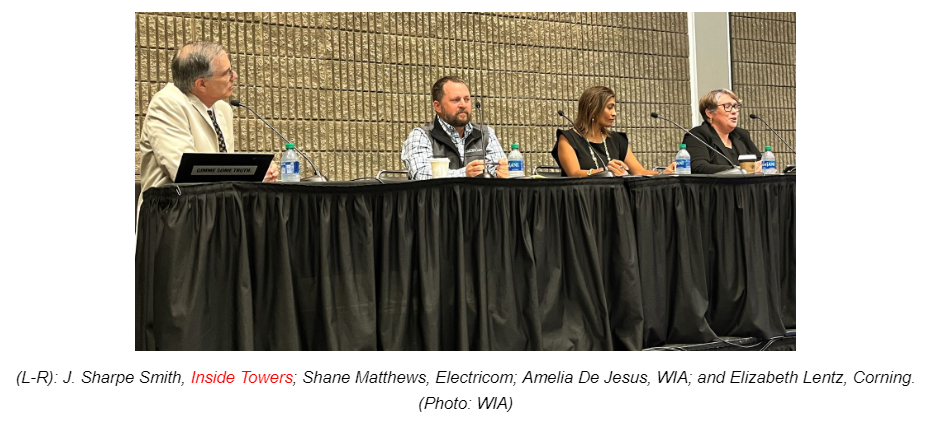The telecom industry is in a state of flux. Contractors have cut back on their installation crews because of the reduction in wireless work. But money from the BEAD Program has yet to be disbursed, which will engage a phalanx of fiber deployment technicians.
It is the calm before the storm for contractors, such as Electricom LLC, as it prepares for the work that will be funded by BEAD. More than $42 billion will be used to expand high-speed internet access through infrastructure deployment and adoption programs, panelists told an audience at the Connectivity Expo last week in Atlanta. The panel, “Successful Strategies for Employee Skill Development in an Unpredictable Market,” was moderated by Inside Towers’ J. Sharpe Smith. The mistake many companies make when a downturn occurs is to cut training, according to Shane Mattews, Training and Development Director at Electricom. However, when the BEAD money comes through, trained installers will be needed to go to work immediately.
“We are trying to maintain our crews during this lull,” Matthews said. “We are trying to reinvest because we know, once we get the green light, it’s going to be Katy-bar-the-door; we’re going to have to go 100 miles-an-hour to deploy the infrastructure.”
Around 300,000 installers will be needed for the five-year buildout, according to the Fiber Broadband Association, as each state rolls out around $100 million in government funding to provide connectivity to unserved and underserved households.
“Corning has created programs where we can teach others in our communities how to install the fiber and fill other jobs that are needed, such as outside plant installers and data center installers,” said Elizabeth Lentz, Fiber IQ Program Manager at Corning. Training is being taken advantage of by construction companies, tower services companies and utility contractors that have entered the fiber business, she added.
Contractors and their workers face challenges in gaining training, including limitations both in time and money, according Amelia De Jesus, Vice President of Workforce Solutions at the Wireless Infrastructure Association (WIA). She said it is critical for an employer to address not only their employees’ training needs but also to consider that their employees already have full time jobs and family obligations.
“It takes a deliberate and concerted effort by the employer to be invested in the future development of an employee,” De Jesus said. “The employer must not only fund training but also provide the time to train, whether it’s online or on weekends or some time during the day.” Wraparound services, which support an employee’s needs for child care or transportation, may be needed to facilitate training, she said.
To manage a successful mentorship program the company needs strong leaders in its ranks, according to Matthews, who said that Electricom is implementing a new program to improve communications between its leaders and crew members. “If you treat an employee like they matter, they will,” Matthews said. “We are creating a mentorship mentality by promoting communications between the leader and the trainee.”
Without encouragement, employees may not want to become involved in the training program, according to De Jesus. When it comes to coaching, it is important to set up a culture of caring, she added, and to reward employees for working extra to get the training.
“It needs to be a sincere type of care, in terms of ensuring that the employee is on the right path, and letting them know they are doing a great job, or [if not] talking with them about other opportunities that may be more appropriate for their aptitude,” she said. “This should allow the trainee to get continuous feedback, so they will understand their opportunities and where they need to improve.”
Developing a skilled workforce begins with having an effective recruitment program, according to Matthews. Instead of exhibiting at career fairs, he suggests that contractors target high school students in vocational technical programs. Along those lines, Corning sponsors the SkillsUSA, which is a career and technical student organization that serves high school, college and middle school students and professionals enrolled in training programs in trade, technical and skilled service occupations.
WIA takes a holistic approach to workforce development including fiber, DAS, and data centers, as well as tower services. To encourage the training of new employees, WIA serves as the national sponsor of the U.S. Department of Labor’s Telecommunications Industry Registered Apprenticeship Program. WIA also has the Telecommunications Education Center, which offers 35 courses that span technologies used by the telecom industry from 5G to fiber to data centers. It partners with individuals, schools, and businesses to provide training, education, and professional development.
Filling new employment opportunities also can draw on existing employees through reskilling, according to De Jesus. “Some of these technician roles can absolutely shift, whether it’s cell site technicians, broadband technicians, or fiber technicians,” she said. “We need to be thinking about those transferable skills, some of those soft skills, some of the technical skills that can be enhanced to allow for folks to be more mobile in their roles.”
By J. Sharpe Smith, Inside Towers Technology Editor





Reader Interactions